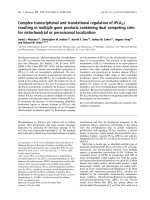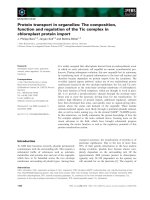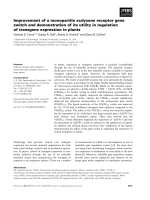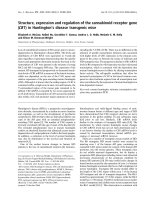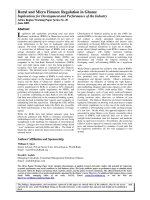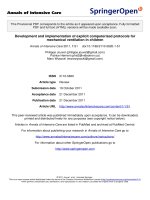89. Development and regulation of pedicel abscission in tomato
Bạn đang xem bản rút gọn của tài liệu. Xem và tải ngay bản đầy đủ của tài liệu tại đây (744.4 KB, 6 trang )
MINI REVIEW
published: 11 June 2015
doi: 10.3389/fpls.2015.00442
Development and regulation of
pedicel abscission in tomato
Yasuhiro Ito* and Toshitsugu Nakano†
Food Biotechnology Division, National Food Research Institute, National Agriculture and Food Research Organization,
Tsukuba, Japan
Edited by:
Shimon Meir,
Agriculture Research Organization,
Israel
Reviewed by:
Cai-Zhong Jiang,
United States Department
of Agriculture - Agricultural Research
Service, USA
Amnon Lers,
Agriculture Research Organization,
Israel
*Correspondence:
Yasuhiro Ito,
Food Biotechnology Division, National
Food Research Institute, National
Agriculture and Food Research
Organization, 2-1-12 Kannondai,
Tsukuba, Ibaraki 305-8642, Japan
†
Present address:
Toshitsugu Nakano, Institute of Crops
Research and Development, Vietnam
National University of Agriculture,
Trau Quy, Gia Lam, Hanoi, Vietnam
Specialty section:
This article was submitted to
Crop Science and Horticulture,
a section of the journal
Frontiers in Plant Science
Received: 30 March 2015
Accepted: 29 May 2015
Published: 11 June 2015
Citation:
Ito Y and Nakano T (2015)
Development and regulation of
pedicel abscission in tomato.
Front. Plant Sci. 6:442.
doi: 10.3389/fpls.2015.00442
To shed unfertilized flowers or ripe fruits, many plant species develop a pedicel abscission
zone (AZ), a specialized tissue that develops between the organ and the main body
of the plant. Regulation of pedicel abscission is an important agricultural concern
because pre-harvest abscission can reduce yields of fruit or grain crops, such as
apples, rice, wheat, etc. Tomato has been studied as a model system for abscission,
as tomato plants develop a distinct AZ at the midpoint of the pedicel and several tomato
mutants, such as jointless, have pedicels that lack an AZ. This mini-review focuses on
recent advances in research on the mechanisms regulating tomato pedicel abscission.
Molecular genetic studies revealed that three MADS-box transcription factors interactively
play a central role in pedicel AZ development. Transcriptome analyses identified activities
involved in abscission and also found novel transcription factors that may regulate AZ
activities. Another study identified transcription factors mediating abscission pathways
from induction signals to activation of cell wall hydrolysis. These recent findings in tomato
will enable significant advances in understanding the regulation of abscission in other key
agronomic species.
Keywords: abscission, pedicel, MADS-box, ERF, tomato
Introduction
Similar to leaves, flowers and young fruits shed when the organs become unneeded or as a result
of environmental stresses; for example, failure of pollination results in abscission of the unfertilized
flowers. Also, in “June drop” in apple (Malus × domestica), some young fruitlets abscise at an early
developmental stage (Bangerth, 2000). Just after flowering, apple trees often bear more fruits than
they can support to maturity; thus the plants shed some fruits to limit fruit set. In addition, when
fruits on a plant ripen, abscission of the fruits helps to disperse the seeds. The pedicel, a stem, or a
stalk structure, connects at the base of the flower or fruit, attaching the organ to the plant body. In
many species, an abscission zone (AZ) forms in the pedicel to enable regulated separation of the fruit
or flower from the main plant body (Sexton and Roberts, 1982; Tabuchi et al., 2001; Roberts et al.,
2002).
In agricultural applications, pedicel abscission is a critical trait directly affecting crop yields; thus
the regulation of abscission has been important since ancient times. During the domestication of
cereal crops such as rice (Oryza sativa), maize (Zea mays), or wheat (Triticum aestivum), early farmers
selected for plants with reduced abscission (Doebley et al., 2006; Li et al., 2006; Lin et al., 2012).
Cultivars carrying the trait conferring resistance to grain abscission retain the grain on the stalk,
rather than dropping it on the ground.
Regulation of abscission also remains an important trait in modern breeding programs. Research
in tomato has identified several mutations that block formation of the pedicel AZ, producing a
“jointless” phenotype (Butler, 1936; Rick, 1967; Roberts et al., 2002), which has proven useful in
Frontiers in Plant Science | www.frontiersin.org
1
June 2015 | Volume 6 | Article 442
Ito and Nakano
Development and regulation of pedicel abscission in tomato
tomato cultivars grown for industrial processing of tomato puree
or juice. In these cultivars, fruits can be mechanically harvested
without the pedicel and sepals because, in the absence of a
breaking point in the pedicel AZ, the fruit detaches at the next
breaking point, the calyx AZ at the proximal end of the fruit, and
the green organs remains on the plant. This reduces the labor and
time required to remove the pedicel and sepals during harvesting
(Zahara and Scheuerman, 1988).
Fruit abscission is also an important trait for tree fruit
production. In apple, abscission affects the fruit yield at several
stages (Celton et al., 2014). The trees shed young fruitlets as
“June drop,” as described above. Thinning of young fruits is
an important practice to control fruit load and chemicals that
induce partial abscission of fruit have been developed to reduce
the labor required for thinning (Bangerth, 2000). After the early
developmental stages, fruits at the expanding stage remain stably
attached to the plant via the pedicels but the attachment gradually
loosens during the initiation of ripening. However, severe weather
can cause fruit to drop prematurely. For example, in Japan,
the autumn fruit harvest coincides with the typhoon season
and large numbers of fruits just before harvest time drop by
the strong winds, which break a boundary between the plant
body and pedicel, where the AZ is localized, resulting in severe
damage to production (Yamamoto et al., 2012; Fujisawa et al.,
2015).
et al., 1984; Wang et al., 2013); several studies have used these
treatments to analyze abscission. Roberts et al. (1984) observed
that cell separation for abscission first took place at the cortex
within the distal side of the AZs if the pedicel was treated
with ethylene. Also, Tabuchi et al. (2001) reported that pedicel
abscission occurred first at the epidermis of the AZ if abscission
was induced by emasculation. Dissolution of the middle lamella
commonly occurred in response to either treatment, and cell
wall hydrolysis enzymes and remodeling proteins, such as
polygalacturonase (tomato abscission-related polygalacturonase;
TAPG), endo-β-1,4-glucanase (also referred as cellulase; Cel),
xyloglucan endotransglucosylase/hydrolase (XTH), and expansin,
play a critical role in abscission (Roberts et al., 2002; Tucker
et al., 2007; Cai and Lashbrook, 2008). The abscission-inducing
treatment also caused enlargement of the epidermal cells in
tomato (Tabuchi et al., 2001). Cell enlargement during abscission
also occurs in other plant systems such as bean leaves (McManus
et al., 1998) and Arabidopsis flower organs (Shi et al., 2011),
and this enlargement may confer mechanical force to facilitate
abscission (Shi et al., 2011). The abscised surface of the proximal
side formed thickened and lignified cell walls, implying that a
protective layer forms to prevent pathogen invasion (Tabuchi
et al., 2001).
MADS-Box Family Transcription Factors
Regulate Pedicel AZ Development in
Tomato
Pedicel AZ Structure and Development in
Tomato
The most important breakthrough in abscission research was
the identification of the jointless (j) mutant locus (Mao et al.,
2000), which causes the plant to fail to develop pedicel AZs.
The j locus was isolated by map-based cloning and the wildtype gene encodes a MADS-box transcription factor. In the same
year, independent work on an early-flowering mutant identified
Arabidopsis SHORT VEGETATIVE PHASE (SVP), which encodes
a MADS-box protein with high similarity to J (Hartmann et al.,
2000). Although J and SVP have high amino acid sequence
similarity, they have distinct functions, with SVP acting as a
repressor of the floral transition. Moreover, Arabidopsis plants do
not shed fruits from the pedicels. Also, in several tree fruit species,
SVP homologs may play roles in bud dormancy (Li et al., 2009;
Yamane et al., 2011; Wu et al., 2012).
Further studies identified two additional tomato MADS-box
genes regulating pedicel AZ development, Macrocalyx (MC) and
SlMBP21. MC was originally identified in a study of rin (ripening
inhibitor), which regulates fruit ripening. The rin mutation
produces non-ripening fruits with large sepals (Vrebalov et al.,
2002). The cloning study identified two nearby genes, RIN and
MC, both of which encode MADS-box genes. RIN regulates
ripening and MC regulates sepal size (Vrebalov et al., 2002).
The rin mutation also shows a weak effect on pedicel AZ
development and antisense-mediated knockdown revealed that
MC also plays a role in pedicel AZ development (Nakano et al.,
2012). A comprehensive interaction study of tomato MADSbox proteins using yeast two-hybrid system initially identified
SlMBP21 as a MADS-box protein interacting with J (Leseberg
et al., 2008). A gene knockdown study revealed that SlMBP21
The AZ, a specialized tissue for organ abscission, forms at a
predetermined site on the organ that will abscise. Anatomical
studies revealed that an AZ includes several layers of small,
densely cytoplasmic cells that forms at an early stage of pedicel
development and proliferation of the cells is observed during
fruit development (Addicott, 1982; Sexton and Roberts, 1982;
Tabuchi and Arai, 2000; Patterson, 2001). These properties suggest
that these cells may be arrested in an undifferentiated state (van
Nocker, 2009). In tomato, initial differentiation of the pedicel AZ
occurs when the flower sepal differentiates from the primordium.
AZ cells first form in the inner region of the young pedicel
and then the AZ structure gradually extends to the outer tissues
(Tabuchi, 1999; Liu et al., 2014). The innermost cell layer has
a critical role in AZ development, as examination of chimeric
plants consisting of layers of jointless mutant cells and wildtype cells showed that the genotype of the inner layer (L3)
determines cell fates of overlaying layers L1 (outer layer) and
L2 (middle layer) and whether they differentiate into AZ tissue
(Szymkowiak and Irish, 1999). At the flower anthesis stage,
pedicel AZ tissues have developed into six to eight cell layers
that extend across the pedicel. The AZ cells around the vascular
tissue and cortex can still divide (Tabuchi and Arai, 2000),
suggesting that the AZs in flower pedicels maintain meristem-like
activity.
Normally, pedicel abscission is induced if flower fertilization
fails or the fruit ripens fully. Pedicel abscission can also be
induced artificially by flower removal (Roberts et al., 1984; Meir
et al., 2010; Nakano et al., 2013) or ethylene treatment (Roberts
Frontiers in Plant Science | www.frontiersin.org
2
June 2015 | Volume 6 | Article 442
Ito and Nakano
Development and regulation of pedicel abscission in tomato
also participates in pedicel AZ development (Liu et al., 2014).
These studies showed physical interactions among J, MC, and
SlMBP21, suggesting that these three MADS-box proteins form
a complex. At an early stage of AZ initiation, these MADS-box
genes are co-expressed in vascular tissue derived from the L3
layer required for AZ development (Szymkowiak and Irish, 1999;
Liu et al., 2014). In Arabidopsis, the J homolog SVP and the MC
homolog AP1 likely form a dimer as an active form to regulate
floral identity (Gregis et al., 2009). SEP family proteins, including
SlMBP21, play an important role in forming multimers of MADSbox proteins by acting as a glue (Immink et al., 2009). Thus,
multimer formation of J, MC, and SlMBP21 may be a conserved
activity among plant species, although the targets of biological
regulation by homologous MADS-box proteins may differ in
each plant.
Is the regulation of pedicel AZ development by the MADSbox transcription factors conserved in other plant species, or
is it specific to tomato? Ectopic expression of the apple SVP
family MADS-box gene MdJb in a tomato j mutant restored
the formation of pedicel AZ structure in the j mutant (Nakano
et al., 2015). The restored AZs showed abscission-associated
expression of cell wall hydrolysis enzyme genes and complete
pedicel abscission, as in wild-type tomato plants. The results
suggest that the regulation of pedicel AZ development in plants by
the MADS-box transcription factors may be conserved, but other
plant systems remain to be examined. Further investigation will
be required to understand the mechanism of AZ development in
other plant species.
as ACS, encoding 1-aminocyclopropane-1-carboxylate (ACC)
synthase), leads to AZ-specific up-regulation of the genes
for abscission, such as genes encoding cell wall-modifying
proteins and pathogenesis-related proteins, development of a
protective layer on the surface of the abscised tissue, and
so on.
Before the onset of pedicel abscission, the plant maintains firm
cell-to-cell adhesion at the AZs to allow continuous growth from
the flower to the mature fruit. To maintain the adhesion and the
competence to react to an abscission-inducing signal, the AZ
cells might undergo specific regulation. A transcriptome analysis
comparing gene expression between pedicel AZs and the flanking
pedicel regions at anthesis (Nakano et al., 2013) identified about
90 genes specifically expressed in AZ cells, including genes
for transcription factors, phytohormone-related proteins, cell
wall modification enzymes, lipid metabolism, and others. Most
interestingly, the AZ-specific gene set included transcription
factor genes that encode key regulators of meristem-associated
functions, including a tomato homolog of WUSCHEL (LeWUS),
GOBLET (GOB), LATERAL SUPPRESSOR (Ls), and Blind
(Bl). WUS expressed in Arabidopsis shoot apex is required for
maintenance of stem cells in an undifferentiated state (Mayer
et al., 1998). GOB is a member of the NAC family transcription
factor genes and its Arabidopsis homolog genes, CUP-SHAPED
COTYLEDONs (CUCs), are involved in shoot meristem formation
and specification of organ boundaries (Aida et al., 1997; Blein
et al., 2008; Berger et al., 2009). Ls and its Arabidopsis homolog
are known to regulate axillary meristem initiation (Schumacher
et al., 1999; Greb et al., 2003). Bl and its Arabidopsis homolog of
REGULATOR OF AXILLARY MERISTEM (RAX) also involved
in axillary meristem formation (Schmitz et al., 2002; Keller
et al., 2006). These transcription factors were suppressed in
the pedicels of AZ-deficient plants, the j mutant, and MC- and
SlMBP21-suppressed plants (Nakano et al., 2012; Liu et al., 2014).
Also, LeWUS, GOB, and Ls were down-regulated immediately
after an abscission-inducing treatment while Bl was up-regulated
(Nakano et al., 2013). These characteristic expression patterns
suggest that these transcription factor genes play important
roles in the AZs. Similar to meristems, AZs include small cells
that likely exist in an undifferentiated state (van Nocker, 2009);
thus, these transcription factors may regulate the maintenance
of these undifferentiated cells in both tissues. In rice flower
pedicels, homologs of Bl, GOB, and Ls are expressed specifically
in the AZs, indicating that the mechanism of regulation by these
transcription factors may be conserved in monocots and dicots
(Nakano and Ito, 2013).
A recent study showed an intriguing result on the
undifferentiated properties of the AZ cells. Constitutive
expression of a miRNA-resistant form of a tomato homolog of the
REVOLUTA gene, encoding a Class III homeodomain-leucine
zipper (HD-ZIP III) transcription factor, caused the transgenic
plants to produce ectopic flowers from the pedicel AZs (Hu et al.,
2014). In the AZs at anthesis, the transgenic plants expressed Bl
and GOB at significantly higher levels than the wild-type plants.
The results imply that pedicel AZs include undifferentiated cells
that have the potential to develop into flower primordia, and
the transcription factors expressed in the AZs may coordinately
Genes Expressed in Tomato Pedicel AZs
Before abscission, pedicel AZs attach the flowers firmly to the
plant body, but when the AZ cells perceive an abscissionstimulating signal, the adhesion immediately starts to loosen.
During abscission, the gene expression pattern in the AZ changes
drastically; genes for cell wall hydrolysis enzymes, such TAPG and
Cel, and for factors regulating programmed cell-death increase
intensely and specifically at the AZ (Roberts et al., 2002; Cai
and Lashbrook, 2008; Meir et al., 2010; Bar-Dror et al., 2011). In
addition to these genes, a transcriptome study during initiation of
abscission found many genes possibly responsible for regulatory
roles in abscission, such as genes for transcription factor families
of ARF, Aux/IAA, KNOX, HAT, bHLH, AP2, NAC, AGL, and
WRKY, genes for components of signal transduction pathways
such as a LRR-RLK and a Ser/Thr protein kinase, and a gene
for a component of a RNA-induced silencing complex, AGO1
(Meir et al., 2010). The analyses also provided specific expression
patterns of phytohormone-related genes, which confirmed and
improved a conventional abscission-inducing model with the
substantial evidence (Patterson, 2001; Roberts et al., 2002; Meir
et al., 2010); a decrease in auxin provides the first signal for
abscission, and reactions to the decrease in auxin, including downregulation of genes induced by auxin (such as Aux/IAA genes
and other transcription factor genes) and up-regulation of genes
repressed by auxin, confers ethylene-sensitivity and abscission
competence to the AZ. Then increased ethylene production, due
to the up-regulation of genes for ethylene biosynthesis (such
Frontiers in Plant Science | www.frontiersin.org
3
June 2015 | Volume 6 | Article 442
Ito and Nakano
Development and regulation of pedicel abscission in tomato
regulate the maintenance and proliferation of the undifferentiated
AZ cells.
These transcriptome analyses identified genes specifically
expressed in tomato pedicel AZs, and of them, two transcription
factor genes, SlERF52 and KD1, were further analyzed for their
effect on AZ functions, as described in the next section.
Transcription Factors Connecting
Abscission-Inducing Signals and
Abscission Processes
Of the transcription factor genes expressed in tomato pedicel AZs,
the ERF family transcription factor gene SlERF52 was further
investigated by RNAi-mediated knockdown assays (Nakano et al.,
2014). The SlERF52-knockdown plants developed pedicel AZ
structures similarly to wild-type plants; however, the responses to
an abscission-inducing treatment differed in the knockdown and
wild-type plants. In wild-type plants, removing the anthesis-stage
flower from the pedicel usually induces pedicel abscission within
2 days; in the SlERF52-knockdown plants, pedicel abscission took
significantly longer. The knockdown disturbed the abscissionspecific up-regulation of the genes for hydrolytic enzymes,
such as TAPG and Cel, indicating that the suppression of the
hydrolytic enzymes caused the delay in abscission. The result
suggests that the SlERF52 ERF transcription factor functions
as a component of a signaling pathway for pedicel abscission
and plays a key role in the induction of expression of genes
involved in cell wall hydrolysis. The induction of the hydrolytic
enzyme genes during abscission, however, may require an
additional factor to activate SlERF52. The expression levels of
SlERF52 did not differ before and after the abscission-inducing
treatment; thus, the expression level of SlERF52 cannot explain
the activation of abscission. On the other hand, before the onset
of abscission, the AZ-specific expression of LeWUS, Ls, and
GOB requires SlERF52, implying that SlERF52 acts before and
during abscission, but the transcriptional targets of SlERF52
apparently differ in the two stages. Explaining the functional
switching of SlERF52 may require additional factors, such as stagespecific co-factors of SlERF52 or repressor proteins at SlERF52binding sites. The identification of the switching mechanism
will provide further insights into the regulation of pedicel
abscission.
Another transcription factor gene expressed specifically in
the tomato pedicel AZ, KD1, a KNOTTED1-LIKE HOMEOBOX
(KNOX) family gene, was investigated for function in pedicel
and petiole AZs (Ma et al., 2015). Down-regulation of KD1
significantly delayed abscission of the pedicel and even petiole
and up-regulation of KD1 promoted abscission. The investigation
suggested that KD1 controls abscission by regulating genes that
modulate auxin levels (Ma et al., 2015). Identification of the
regulator of abscission in both pedicels and petioles provides
substantial evidence that abscission in these tissues involves
identical regulatory mechanisms, in contrast to their distinct
mechanisms regulating AZ development (Szymkowiak and Irish,
1999). Further investigation of the relationship between SlERF52
and KD1 may reveal their activities in abscission processes more
clearly.
Frontiers in Plant Science | www.frontiersin.org
FIGURE 1 | Regulation of pedicel AZ functions. 1. MADS-box proteins
form tetramers and regulate pedicel AZ formation. 2. Undifferentiated
cells are maintained in the pedicel AZ. AZ-specific transcription
factors may be involved in the maintenance and proliferation of the
undifferentiated cells. Expression of these transcription factor genes
requires the activity of SlERF52. 3. In response to abscission-initiating
signals, KD1 and SlERF52 activate abscission by modulating auxin levels
and up-regulating genes encoding cell wall hydrolysis enzymes,
respectively.
Conclusion
These recent advances in our understanding of the regulation
of pedicel abscission revealed key factors involved in AZ
development and signal transduction in the initiation of
abscission. Figure 1 shows a current model of development
of AZs and induction of abscission in tomato pedicels. The
MADS-box transcription factor complex regulates pedicel AZ
development. The developed AZ contains undifferentiated cells,
probably maintained by a mechanism similar to that found in
meristems. The signals of decreased auxin and increased ethylene
induce abscission and SlERF52 and KD1 possibly connect the
phytohormone signaling pathway and abscission processes. A
remaining mystery is another tomato jointless mutation, jointless2 (j-2), which is the best used mutation in practical breeding
programs of processing tomatoes. A candidate gene for the
mutation was reported but it has not been fully identified yet
(Yang et al., 2005).
The outline of the current model constructed in tomato will
facilitate further detailed studies on pedicel functions in tomato
and other plants and these studies will provide new applications
for fruit crops to improve their productivities.
Acknowledgment
This work was supported by Science Technique Research
Promotion program for Agriculture, Forestry, Fisheries and Food
industry (grant number 25005A).
4
June 2015 | Volume 6 | Article 442
Ito and Nakano
Development and regulation of pedicel abscission in tomato
References
Liu, D., Wang, D., Qin, Z., Zhang, D., Yin, L., Wu, L., et al. (2014). The SEPALLATA
MADS-box protein SLMBP21 forms protein complexes with JOINTLESS and
MACROCALYX as a transcription activator for development of the tomato
flower abscission zone. Plant J. 77, 284–296. doi: 10.1111/tpj.12387
Ma, C., Meir, S., Xiao, L., Tong, J., Liu, Q., Reid, M. S., et al. (2015). A KNOTTED1LIKE HOMEOBOX protein regulates abscission in tomato by modulating the
auxin pathway. Plant Physiol. 167, 844–853. doi: 10.1104/pp.114.253815
Mao, L., Begum, D., Chuang, H. W., Budiman, M. A., Szymkowiak, E. J., Irish, E.
E., et al. (2000). JOINTLESS is a MADS-box gene controlling tomato flower
abscission zone development. Nature 406, 910–913. doi: 10.1038/35022611
Mayer, K. F., Schoof, H., Haecker, A., Lenhard, M., Jürgens, G., and Laux, T.
(1998). Role of WUSCHEL in regulating stem cell fate in the Arabidopsis shoot
meristem. Cell 95, 805–815.
McManus, M. T., Thompson, D. S., Merriman, C., Lyne, L., and Osborne, D. J.
(1998). Transdifferentiation of mature cortical cells to functional abscission cells
in bean. Plant Physiol. 116, 891–899.
Meir, S., Philosoph-Hadas, S., Sundaresan, S., Selvaraj, K. S., Burd, S., Ophir, R.,
et al. (2010). Microarray analysis of the abscission-related transcriptome in the
tomato flower abscission zone in response to auxin depletion. Plant Physiol. 154,
1929–1956. doi: 10.1104/pp.110.160697
Nakano, T., Fujisawa, M., Shima, Y., and Ito, Y. (2013). Expression profiling of
tomato pre-abscission pedicels provides insights into abscission zone properties
including competence to respond to abscission signals. BMC Plant Biol. 13:40.
doi: 10.1186/1471-2229-13-40
Nakano, T., Fujisawa, M., Shima, Y., and Ito, Y. (2014). The AP2/ERF transcription
factor SlERF52 functions in flower pedicel abscission in tomato. J. Exp. Bot. 65,
3111–3119. doi: 10.1093/jxb/eru154
Nakano, T., and Ito, Y. (2013). Molecular mechanisms controlling plant organ
abscission. Plant Biotechnol. 30, 209–216. doi: 10.5511/plantbiotechnology.
13.0318a
Nakano, T., Kato, H., Shima, Y., and Ito, Y. (2015). Apple SVP family MADSbox proteins and the tomato pedicel abscission zone regulator JOINTLESS have
similar molecular activities. Plant Cell Physiol. doi: 10.1093/pcp/pcv034 [Epub
ahead of print].
Nakano, T., Kimbara, J., Fujisawa, M., Kitagawa, M., Ihashi, N., Maeda, H., et
al. (2012). MACROCALYX and JOINTLESS interact in the transcriptional
regulation of tomato fruit abscission zone development. Plant Physiol. 158,
439–450. doi: 10.1104/pp.111.183731
Patterson, S. E. (2001). Cutting loose. Abscission and dehiscence in Arabidopsis.
Plant Physiol. 126, 494–500. doi: 10.1104/pp.126.2.494
Rick, C. M. (1967). Fruit and pedicel characters derived from galapagos tomatoes.
Econ. Bot. 21, 171–184.
Roberts, J. A., Elliott, K. A., and Gonzalez-Carranza, Z. H. (2002). Abscission,
dehiscence, and other cell separation processes. Annu. Rev. Plant Biol. 53,
131–158. doi: 10.1146/annurev.arplant.53.092701.180236
Roberts, J. A., Schindler, C. B., and Tucker, G. A. (1984). Ethylene-promoted tomato
flower abscission and the possible involvement of an inhibitor. Planta 160,
159–163.
Schmitz, G., Tillmann, E., Carriero, F., Fiore, C., Cellini, F., and Theres, K. (2002).
The tomato Blind gene encodes a MYB transcription factor that controls the
formation of lateral meristems. Proc. Natl. Acad. Sci. U.S.A. 99, 1064–1069. doi:
10.1073/pnas.022516199
Schumacher, K., Schmitt, T., Rossberg, M., Schmitz, G., and Theres, K. (1999). The
lateral suppressor (Ls) gene of tomato encodes a new member of the VHIID
protein family. Proc. Natl. Acad. Sci. U.S.A. 96, 290–295.
Sexton, R., and Roberts, J. A. (1982). Cell biology of abscission. Annu. Rev. Plant
Physiol. Plant Mol. Biol. 33, 133–162.
Shi, C. L., Stenvik, G. E., Vie, A. K., Bones, A. M., Pautot, V., Proveniers, M., et al.
(2011). Arabidopsis class I KNOTTED-like homeobox proteins act downstream
in the IDA-HAE/HSL2 floral abscission signaling pathway. Plant Cell 23,
2553–2567. doi: 10.1105/tpc.111.084608
Szymkowiak, E. J., and Irish, E. E. (1999). Interactions between jointless and wildtype tomato tissues during development of the pedicel abscission zone and the
inflorescence meristem. Plant Cell 11, 159–175.
Tabuchi, T. (1999). Comparison on the development of abscission zones in the
pedicels between two tomato cultivars. J. Japan Soc. Hort. Sci. 68, 939–999.
Tabuchi, T., and Arai, N. (2000). Formation of the secondary cell division zone
in tomato pedicels at different fruit growing stages. J. Japan Soc. Hort. Sci. 69,
156–160. doi: 10.2503/jjshs.69.156
Addicott, F. T. (1982). Abscission. Oakland, CA: University of California Press.
Aida, M., Ishida, T., Fukaki, H., Fujisawa, H., and Tasaka, M. (1997). Genes involved
in organ separation in Arabidopsis: an analysis of the cup-shaped cotyledon
mutant. Plant Cell 9, 841–857. doi: 10.1105/tpc.9.6.841
Bangerth, F. (2000). Abscission and thinning of young fruit and their regulation
by plant hormones and bioregulators. Plant Growth Regul. 31, 43–59. doi:
10.1023/A:1006398513703
Bar-Dror, T., Dermastia, M., Kladnik, A., Znidaric, M. T., Novak, M. P., Meir, S., et
al. (2011). Programmed cell death occurs asymmetrically during abscission in
tomato. Plant Cell 23, 4146–4163. doi: 10.1105/tpc.111.092494
Berger, Y., Harpaz-Saad, S., Brand, A., Melnik, H., Sirding, N., Alvarez, J.
P., et al. (2009). The NAC-domain transcription factor GOBLET specifies
leaflet boundaries in compound tomato leaves. Development 136, 823–832.
doi: 10.1242/dev.031625
Blein, T., Pulido, A., Vialette-Guiraud, A., Nikovics, K., Morin, H., Hay, A., et al.
(2008). A conserved molecular framework for compound leaf development.
Science 322, 1835–1839. doi: 10.1126/science.1166168
Butler, L. (1936). Inherited characters in the tomato. II. Jointless pedicel. J. Hered.
37, 25–26.
Cai, S., and Lashbrook, C. C. (2008). Stamen abscission zone transcriptome
profiling reveals new candidates for abscission control: enhanced retention
of floral organs in transgenic plants overexpressing Arabidopsis ZINC
FINGER PROTEIN2. Plant Physiol. 146, 1305–1321. doi: 10.1104/pp.107.
110908
Celton, J. M., Kelner, J. J., Martinez, S., Bechti, A., Khelifi Touhami, A., James, M.
J., et al. (2014). Fruit self-thinning: a trait to consider for genetic improvement
of apple tree. PLoS ONE 9:e91016. doi: 10.1371/journal.pone.0091016
Doebley, J. F., Gaut, B. S., and Smith, B. D. (2006). The molecular genetics of crop
domestication. Cell 127, 1309–1321. doi: 10.1016/j.cell.2006.12.006
Fujisawa, M., Kobayashi, K., Johnston, P., and New, M. (2015). What drives farmers
to make top-down or bottom-up adaptation to climate change and fluctuations?
A comparative study on 3 cases of apple farming in Japan and South Africa. PLoS
ONE 10:e0120563. doi: 10.1371/journal.pone.0120563
Greb, T., Clarenz, O., Schafer, E., Muller, D., Herrero, R., Schmitz, G., et al. (2003).
Molecular analysis of the LATERAL SUPPRESSOR gene in Arabidopsis reveals
a conserved control mechanism for axillary meristem formation. Genes Dev. 17,
1175–1187. doi: 10.1101/gad.260703
Gregis, V., Sessa, A., Dorca-Fornell, C., and Kater, M. M. (2009). The Arabidopsis
floral meristem identity genes AP1, AGL24 and SVP directly repress class
B and C floral homeotic genes. Plant J. 60, 626–637. doi: 10.1111/j.1365313X.2009.03985.x
Hartmann, U., Höhmann, S., Nettesheim, K., Wisman, E., Saedler, H., and Huijser,
P. (2000). Molecular cloning of SVP: a negative regulator of the floral transition
in Arabidopsis. Plant J. 21, 351–360. doi: 10.1046/j.1365-313x.2000.00682.x
Hu, G., Fan, J., Xian, Z., Huang, W., Lin, D., and Li, Z. (2014). Overexpression of
SlREV alters the development of the flower pedicel abscission zone and fruit
formation in tomato. Plant Sci. 229, 86–95. doi: 10.1016/j.plantsci.2014.08.010
Immink, R. G., Tonaco, I. A., De Folter, S., Shchennikova, A., Van Dijk, A.
D., Busscher-Lange, J., et al. (2009). SEPALLATA3: the ‘glue’ for MADS box
transcription factor complex formation. Genome Biol. 10, R24. doi: 10.1186/gb2009-10-2-r24
Keller, T., Abbott, J., Moritz, T., and Doerner, P. (2006). Arabidopsis REGULATOR
OF AXILLARY MERISTEMS1 controls a leaf axil stem cell niche and
modulates vegetative development. Plant Cell 18, 598–611. doi: 10.1105/tpc.105.
038588
Leseberg, C. H., Eissler, C. L., Wang, X., Johns, M. A., Duvall, M. R., and Mao, L.
(2008). Interaction study of MADS-domain proteins in tomato. J. Exp. Bot. 59,
2253–2265. doi: 10.1093/jxb/ern094
Li, C., Zhou, A., and Sang, T. (2006). Rice domestication by reducing shattering.
Science 311, 1936–1939. doi: 10.1126/science.1123604
Li, Z., Reighard, G. L., Abbott, A. G., and Bielenberg, D. G. (2009). Dormancyassociated MADS genes from the EVG locus of peach [Prunus persica (L.)
Batsch] have distinct seasonal and photoperiodic expression patterns. J. Exp. Bot.
60, 3521–3530. doi: 10.1093/jxb/erp195
Lin, Z., Li, X., Shannon, L. M., Yeh, C. T., Wang, M. L., Bai, G., et al. (2012). Parallel
domestication of the Shattering1 genes in cereals. Nat. Genet. 44, 720–724. doi:
10.1038/ng.2281
Frontiers in Plant Science | www.frontiersin.org
5
June 2015 | Volume 6 | Article 442
Ito and Nakano
Development and regulation of pedicel abscission in tomato
Tabuchi, T., Ito, S., and Arai, N. (2001). Anatomical studies of the abscission process
in the tomato pedicels at flowering stage. J. Japan Soc. Hort. Sci. 70, 63–65. doi:
10.2503/jjshs.70.63
Tucker, M. L., Burke, A., Murphy, C. A., Thai, V. K., and Ehrenfried, M. L.
(2007). Gene expression profiles for cell wall-modifying proteins associated with
soybean cyst nematode infection, petiole abscission, root tips, flowers, apical
buds, and leaves. J. Exp. Bot. 58, 3395–3406. doi: 10.1093/jxb/erm188
van Nocker, S. (2009). Development of the abscission zone. Stewart Postharvest Rev.
1, 1–6. doi: 10.2212/spr.2009.1.5
Vrebalov, J., Ruezinsky, D., Padmanabhan, V., White, R., Medrano, D.,
Drake, R., et al. (2002). A MADS-box gene necessary for fruit ripening
at the tomato ripening-inhibitor (rin) locus. Science 296, 343–346. doi:
10.1126/science.1068181
Wang, X., Liu, D., Li, A., Sun, X., Zhang, R., Wu, L., et al. (2013). Transcriptome
analysis of tomato flower pedicel tissues reveals abscission zone-specific
modulation of key meristem activity genes. PLoS ONE 8:e55238. doi:
10.1371/journal.pone.0055238
Wu, R. M., Walton, E. F., Richardson, A. C., Wood, M., Hellens, R. P., and VarkonyiGasic, E. (2012). Conservation and divergence of four kiwifruit SVP-like MADSbox genes suggest distinct roles in kiwifruit bud dormancy and flowering. J. Exp.
Bot. 63, 797–807. doi: 10.1093/jxb/err304
Yamamoto, T., Ito, M., and Harako, T. (2012). Mechanism of wind fruit drop and
its prevention by physical reinforcement near fruit stalk in apple and pear (in
Japanese). Bull Yamagata Univ. Agr. Sci. 16, 133–143.
Frontiers in Plant Science | www.frontiersin.org
Yamane, H., Ooka, T., Jotatsu, H., Hosaka, Y., Sasaki, R., and Tao, R. (2011).
Expressional regulation of PpDAM5 and PpDAM6, peach (Prunus persica)
dormancy-associated MADS-box genes, by low temperature and dormancybreaking reagent treatment. J. Exp. Bot. 62, 3481–3488. doi: 10.1093/jxb/
err028
Yang, T. J., Lee, S., Chang, S. B., Yu, Y., De Jong, H., and Wing, R. A. (2005).
In-depth sequence analysis of the tomato chromosome 12 centromeric region:
identification of a large CAA block and characterization of pericentromere
retrotranposons. Chromosoma 114, 103–117. doi: 10.1007/s00412-0050342-8
Zahara, M. B., and Scheuerman, R. W. (1988). Hand-harvesting jointless vs. jointedstem tomatoes. Calif. Agr. 42, 14–14.
Conflict of Interest Statement: The authors declare that the research was
conducted in the absence of any commercial or financial relationships that could
be construed as a potential conflict of interest.
Copyright © 2015 Ito and Nakano. This is an open-access article distributed under the
terms of the Creative Commons Attribution License (CC BY). The use, distribution or
reproduction in other forums is permitted, provided the original author(s) or licensor
are credited and that the original publication in this journal is cited, in accordance with
accepted academic practice. No use, distribution or reproduction is permitted which
does not comply with these terms.
6
June 2015 | Volume 6 | Article 442
